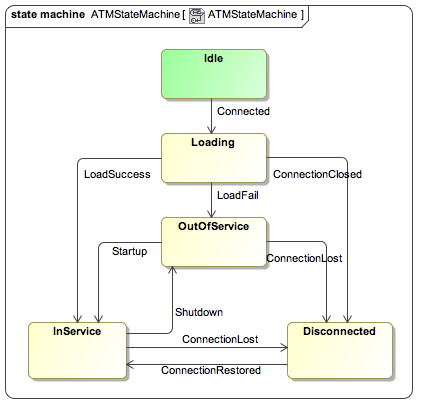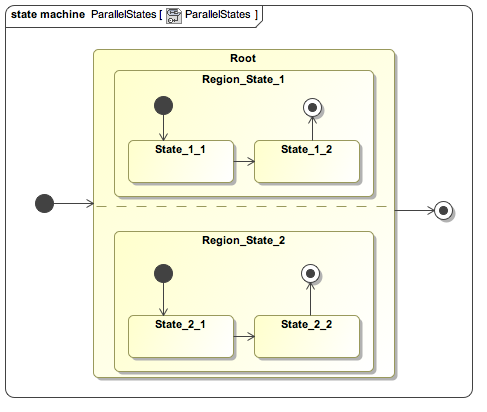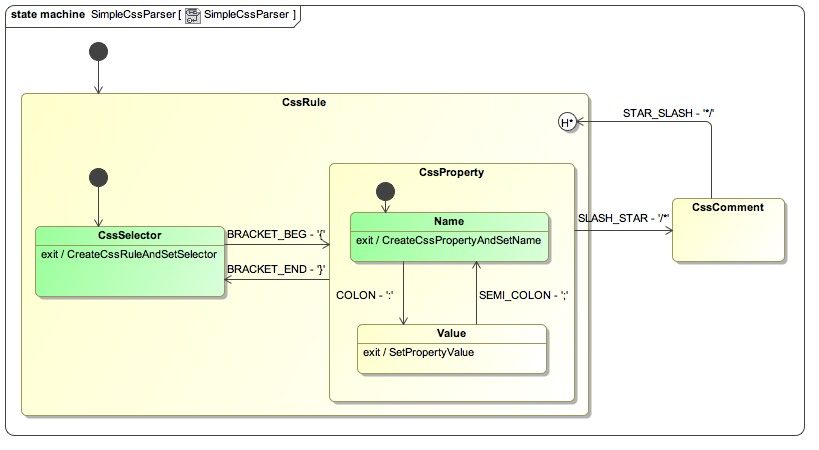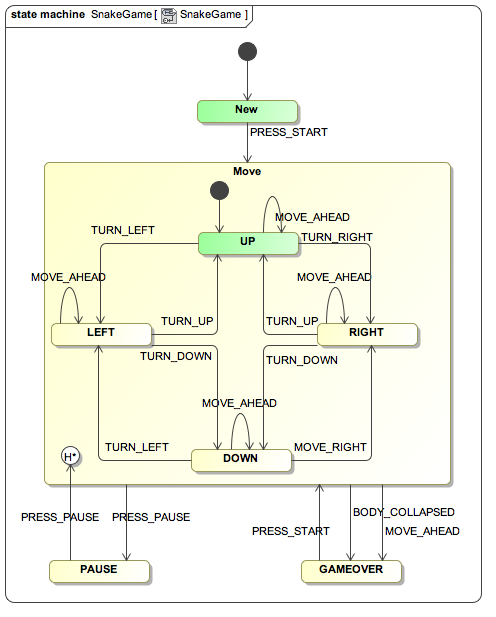Just like the squirrel, a small, agile, smart, alert and cute animal, squirrel-foundation is aimed to provide a lightweright, highly flexible and extensible, diagnosable, easy use and type safe Java state machine implementation for enterprise usage.
Here is the state machine diagram which describes the state change of an ATM:
The sample code could be found in package "org.squirrelframework.foundation.fsm.atm".
squirrel-foundation has been deployed to maven central repository, so you only need to add following dependency to the pom.xml.
Latest Released Version:
<dependency>
<groupId>org.squirrelframework</groupId>
<artifactId>squirrel-foundation</artifactId>
<version>0.2.1</version>
</dependency>
Latest Snapshot Version:
<dependency>
<groupId>org.squirrelframework</groupId>
<artifactId>squirrel-foundation</artifactId>
<version>0.2.2-SNAPSHOT</version>
</dependency>
squirrel-foundation supports both fluent API and declarative manner to declare a state machine, and also enable user to define the action methods in a straightforward manner.
-
StateMahcine interface takes four generic type parameters.
- T stands for the type of implemented state machine.
- S stands for the type of implemented state.
- E stands for the type of implemented event.
- C stands for the type of implemented external context.
-
State Machine Builder
- The StateMachineBuilder is composed of *TransitionBuilder (InternalTransitionBuilder / LocalTransitionBuilder / ExternalTransitionBuilder) which is used to build transition between states, and EntryExitActionBuilder which is used to build the actions during entry or exit state.
- The internal state is implicitly built during transition creation or state action creation.
In order to create a state machine, user need to create state machine builder first. For example:
StateMachineBuilder<MyStateMachine, MyState, MyEvent, MyContext> builder = StateMachineBuilderFactory.create(MyStateMachine.class, MyState.class, MyEvent.class, MyContext.class);
-
Fluent API
After state machine builder was created, we can use fluent API to define state/transition/action of the state machine.
builder.externalTransition().from(MyState.A).to(MyState.B).on(MyEvent.GoToB);An external transition is built between state 'A' to state 'B' and triggered on received event 'GoToB'.
builder.internalTransition().within(MyState.A).on(MyEvent.WithinA).perform(myAction);An internal transition is build inside state 'A' on event 'WithinA' perform 'myAction'. The internal transition means after transition complete, no state is exited or entered.
builder.externalTransition().from(MyState.C).to(MyState.D).on(MyEvent.GoToD).when(
new Condition<MyContext>() {
@Override
public boolean isSatisfied(MyContext context) {
return context!=null && context.getValue()>80;
}
});An conditional transition is built from state 'C' to state 'D' on event 'GoToD' when external context satisfied the condition restriction.
builder.onEntry(MyState.A).perform(Lists.newArrayList(action1, action2))A list of state entry actions is defined.
-
Method Call Action
User can define actions during define transitions or state entry actions. However, the actions will be scattered over the definitions method blocks and other classes. Moreover, other user cannot override the actions. Thus, squirrel-foundation also support define method call actions within state machine implementation in a Convention Over Configuration manner.
Basically, this means that if the method declared in state machine satisfied naming and parameters convention, it will be added into the transition action list and also be invoked at certain phase. e.g.protected void transitFromAToBOnGoToB(MyState from, MyState to, MyEvent event, MyContext context)
The method named as transitFrom[SourceStateName]To[TargetStateName]On[EventName], and parameterized as [MyState, MyState, MyEvent, MyContext] will be added into transition "A-(GoToB)->B" action list. When transiting from state 'A' to state 'B' on event 'GoToB', this method will be invoked.
protected void transitFromAnyToBOnGoToB(MyState from, MyState to, MyEvent event, MyContext context)
transitFromAnyTo[TargetStateName]On[EventName] The method will be invoked when transit from any state to state 'B' on event 'GoToB'.
protected void exitA(MyState from, MyState to, MyEvent event, MyContext context)
exit[StateName] The method will be invoked when exit state 'A'. So as the entry[StateName] , exitAny and entryAny.
Other Supported Naming Patterns:
transitFrom[fromStateName]To[toStateName]On[eventName]When[conditionName] transitFrom[fromStateName]To[toStateName]On[eventName] transitFromAnyTo[toStateName]On[eventName] transitFrom[fromStateName]ToAnyOn[eventName] transitFrom[fromStateName]To[toStateName] on[eventName] -
Declarative Annotation
Use conventional way to define action method call is convenient, but sometimes user may want to give method a more meaningful name. Moreover, the java compiler cannot help user to detect the error when misspelling the method name. For this case, a declarative way is also provided to define and also to extend the state machine. Here is an example.@States({ @State(name="A", entryCallMethod="entryStateA", exitCallMethod="exitStateA"), @State(name="B", entryCallMethod="entryStateB", exitCallMethod="exitStateB") }) @Transitions({ @Transit(from="A", to="B", on="GoToB", callMethod="stateAToStateBOnGotoB"), @Transit(from="A", to="A", on="WithinA", callMethod="stateAToStateAOnWithinA", type=TransitionType.INTERNAL) }) interface MyStateMachine extends StateMachine<MyStateMachine, MyState, MyEvent, MyContext> { void entryStateA(MyState from, MyState to, MyEvent event, MyContext context); void stateAToStateBOnGotoB(MyState from, MyState to, MyEvent event, MyContext context) void stateAToStateAOnWithinA(MyState from, MyState to, MyEvent event, MyContext context) void exitStateA(MyState from, MyState to, MyEvent event, MyContext context); ... }
The annotation can be defined in both implementation class of state machine or any interface that state machine will be implemented. It also can be used mixed with fluent API, which means the state machine defined in fluent API can also be extended by these annotations. (One thing you may need to be noticed, the method defined within interface must be public, which means also the method call action implementation will be public to caller.)
-
Converters
In order to declare state and event within @State and @Transit, user need to implement corresponding converters for their state(S) and event(E) type. The convert must implement Converter<T> interface, which convert the state/event to/from String.
public interface Converter<T> extends SquirrelComponent {
/**
* Convert object to string.
* @param obj converted object
* @return string description of object
*/
String convertToString(T obj);
/**
* Convert string to object.
* @param name name of the object
* @return converted object
*/
T convertFromString(String name);
}Then register these converters to ConverterProvider. e.g.
ConverterProvider.INSTANCE.register(MyEvent.class, new MyEventConverter());
ConverterProvider.INSTANCE.register(MyState.class, new MyStateConverter());*Note: If you only use fluent API to define state machine, there is no need to implement corresponding converters. And also if the Event or State class is type of String or Enumeration, you don't need to implement or register a converter explictly at most of cases.*
- New State Machine Instance
After user defined state machine behavior, user could create a new state machine instance through builder. Note, once the state machine instance is created from the builder, the builder cannot used to define any new element of state machine anymore.
T newStateMachine(S initialStateId, Object... extraParams);To create a new state machine instance from state machine builder, you need to pass following parameters. 1. initialStateId: When started, the initial state of the state machine. 2. extraParams: Extra parameters that needed for create new state machine instance. Set to "new Object[0]" for no extra parameters needed.
New state machine from state machine builder.
```java
MyStateMachine stateMachine = builder.newStateMachine(MyState.Initial, new Object[0]);
```
- Fire Events
After state machine was created, user can fire events along with context to trigger transition inside state machine. e.g.stateMachine.fire(MyEvent.Prepare, new MyContext("Testing"));
- Define Hierarchical State
A hierarchical state may contain nested state. The child states may themselves have nested children and the nesting may proceed to any depth. When a hierarchical state is active, one and only one of its child states is active. The hierarchical state can be defined through API or annotation.
void defineSequentialStatesOn(S parentStateId, S... childStateIds);builder.defineHierarchyOn(State.A, State.BinA, StateCinA) defines two child states "BinA" and "CinA" under parent state "A", the first defined child state will also be the initial state of the hierarchical state "A". The same hierarchical state can also be defined through annotation, e.g.
@States({
@State(name="A", entryMethodCall="entryA", exitMethodCall="exitA"),
@State(parent="A", name="BinA", entryMethodCall="entryBinA", exitMethodCall="exitBinA", initialState=true),
@State(parent="A", name="CinA", entryMethodCall="entryCinA", exitMethodCall="exitCinA")
})- Define Parallel State
The parallel state encapsulates a set of child states which are simultaneously active when the parent element is active. The parallel state can be defined through API or annotation both. e.g.
// defines two region states "RegionState1" and "RegionState2" under parent parallel state "Root"
builder.defineParallelStatesOn(MyState.Root, MyState.RegionState1, MyState.RegionState2);
builder.defineSequentialStatesOn(MyState.RegionState1, MyState.State11, MyState.State12);
builder.externalTransition().from(MyState.State11).to(MyState.State12).on(MyEvent.Event1);
builder.defineSequentialStatesOn(MyState.RegionState2, MyState.State21, MyState.State22);
builder.externalTransition().from(MyState.State21).to(MyState.State22).on(MyEvent.Event2);or
@States({
@State(name="Root", entryCallMethod="enterRoot", exitCallMethod="exitRoot", compositeType=StateCompositeType.PARALLEL),
@State(parent="Root", name="RegionState1", entryCallMethod="enterRegionState1", exitCallMethod="exitRegionState1"),
@State(parent="Root", name="RegionState2", entryCallMethod="enterRegionState2", exitCallMethod="exitRegionState2")
})To get current sub states of the parallel state
stateMachine.getSubStatesOn(MyState.Root); // return list of current sub states of parallel state- Using History States to Save and Restore the Current State
The history pseudo-state allows a state machine to remember its state configuration. A transition taking the history state as its target will return the state machine to this recorded configuration. If the 'type' of a history is "shallow", the state machine processor must record the direct active children of its parent before taking any transition that exits the parent. If the 'type' of a history is "deep", the state machine processor must record all the active descendants of the parent before taking any transition that exits the parent.
Both API and annotation are supported to define history type of state. e.g.
// defined history type of state "A" as "deep"
builder.defineSequentialStatesOn(MyState.A, HistoryType.DEEP, MyState.A1, MyState.A2)or
@State(parent="A", name="A1", entryCallMethod="enterA1", exitCallMethod="exitA1", historyType=HistoryType.DEEP)-
Transition Types
According to the UML specification, a transition may be one of these three kinds:- Internal Transition Implies that the Transition, if triggered, occurs without exiting or entering the source State (i.e., it does not cause a state change). This means that the entry or exit condition of the source State will not be invoked. An internal Transition can be taken even if the StateMachine is in one or more Regions nested within the associated State.
- Local Transition
Implies that the Transition, if triggered, will not exit the composite (source) State, but it will exit and re-enter any state within the composite State that is in the current state configuration. - External Transition
Implies that the Transition, if triggered, will exit the composite (source) State
squirrel-foundation supports both API and annotation to declare all kinds of transitions, e.g.
builder.externalTransition().from(MyState.A).to(MyState.B).on(MyEvent.A2B); builder.internalTransition().within(MyState.A).on(MyEvent.innerA); builder.localTransition().from(MyState.A).to(MyState.CinA).on(MyEvent.intoC)
or
@Transitions({ @Transition(from="A", to="B", on="A2B"), //default value of transition type is EXTERNAL @Transition(from="A", on="innerA", type=TransitionType.INTERNAL), @Transition(from="A", to="CinA", on="intoC", type=TransitionType.LOCAL), })
-
State Machine Lifecycle Events
During the lifecycle of the state machine, various events will be fired, e.g.
|--StateMachineEvent /* Base event of all state machine event */
|--StartEvent /* Fired when state machine started */
|--TerminateEvent /* Fired when state machine terminated */
|--TransitionEvent /* Base event of all transition event */
|--TransitionBeginEvent /* Fired when transition began */
|--TransitionCompleteEvent /* Fired when transition completed */
|--TransitionExceptionEvent /* Fired when transition threw exception */
|--TransitionDeclinedListener /* Fired when transition declined */
User can add a listener to listen StateMachineEvent, which means all events fired during state machine lifecycle will be caught by this listener, e.g.,
stateMachine.addStateMachineListener(new StateMachineListener<MyStateMachine, MyState, MyEvent, MyContext>() {
@Override
public void stateMachineEvent(StateMachineEvent<MyStateMachine, MyState, MyEvent, MyContext> event) {
// ...
}
});-
State Machine PostProcessor
User can register post processor for specific type of state machine in order to adding post process logic after state machine instantiated, e.g.// 1 User defined a state machine interface interface MyStateMachine extends StateMachine<MyStateMachine, MyState, MyEvent, MyContext> { . . . } // 2 Both MyStateMachineImpl and MyStateMachineImplEx are implemented MyStateMachine class MyStateMachineImpl implements MyStateMachine { . . . } class MyStateMachineImplEx implements MyStateMachine { . . . } // 3 User define a state machine post processor MyStateMachinePostProcessor implements SquirrelPostProcessor<MyStateMachine> { void postProcess(MyStateMachine component) { . . . } } // 4 User register state machine post process SquirrelPostProcessorProvider.getInstance().register(MyStateMachine.class, MyStateMachinePostProcessor.class);
For this case, when user created both MyStateMachineImpl and MyStateMachineImplEx instance, the registered post processor MyStateMachinePostProcessor will be called to do some work.
-
State Machine Intercepter
User can register intercepter for specific type of state machine to insert custom logic during state machine lifecycle.public abstract class AbstractStateMachineIntercepter<T extends StateMachine<T, S, E, C>, S, E, C> implements StateMachineIntercepter<T, S, E, C>, SquirrelPostProcessor<T> { . . . }
User can insert custom logic at different state machine process phases by creating a state machine intercepter which is extended from AbstractStateMachineIntercepter. Actually, the AbstractStateMachineIntercepter also implemented SquirrelPostProcessor interface. It will add a StateMachineEvent listener into the state machine, and dispatch the method call according to the event type. Thus, the StateMachineIntercepter registration should be the same as state machine post processor.
By leveraging state machine intercepter, user can implement various monitors for performance analysis, exception diagnose and so on. -
State Machine Export
SCXMLVisitor can be used to export state machine definition in [SCXML] 2 document.
SCXMLVisitor<MyStateMachine, MyState, MyEvent, MyContext> visitor = SquirrelProvider.getInstance().newInstance(
new TypeReference<SCXMLVisitor<MyStateMachine, MyState, MyEvent, MyContext>>() {});
stateMachine.accept(visitor);
visitor.convertSCXMLFile("MyStateMachine", true);DotVisitor can be used to generate state diagram which can be viewed by [GraphViz] 3.
DotVisitor<SnakeController, SnakeState, SnakeEvent, SnakeContext> visitor = SquirrelProvider.getInstance().newInstance(
new TypeReference<DotVisitor<SnakeController, SnakeState, SnakeEvent, SnakeContext>>() {});
stateMachine.accept(visitor);
visitor.convertDotFile("SnakeStateMachine");- Save/Load State Machine Data
User can save data of state machine when state machine is in idle status.
StateMachineData.Reader<MyStateMachine, MyState, MyEvent, MyContext>
savedData = stateMachine.dumpSavedData();And also user can load above savedData into another state machine whose status is terminated or just initialized.
newStateMachineInstance.loadSavedData(savedData);-
State Machine Diagnose
User can register various monitors as state machine intercepter to observe internal status of the state machine, like the execution performance, action calling sequence, transition progress and so on.
For example, the following code is used to register an execution time monitor for state machine of MyStateMachine type.SquirrelPostProcessorProvider.getInstance().register(MyStateMachine.class, new TypeReference<TransitionExecTimeMonitor<MyStateMachine, MyState, MyEvent, MyContext>>() {});
The following code is used to monitor transition progress by adding a TransitionProgressMonitor to ActionExecutor to monitor transition action execution.
SquirrelPostProcessorProvider.getInstance().register( new TypeReference<ActionExecutor<MyStateMachine, MyState, MyEvent, MyContext>>(){}, new SquirrelPostProcessor<ActionExecutor<MyStateMachine, MyState, MyEvent, MyContext>>() { @Override public void postProcess(ActionExecutor<MyStateMachine, MyState, MyEvent, MyContext> component) { component.addExecActionListener(new TransitionProgressMonitor<MyStateMachine, MyState, MyEvent, MyContext>()); } } );
Add @LogExecTime on action method will log out the execution time of the method. And also add the @LogExecTime on state machine class will log out all the action method execution time. For example, the execution time of method transitFromAToBOnGoToB will be logged out.
@LogExecTime protected void transitFromAToBOnGoToB(MyState from, MyState to, MyEvent event, MyContext context)
-
Linked State (so called Submachine State)
A linked state specifies the insertion of the specification of a submachine state machine. The state machine that contains the linked state is called the containing state machine. The same state machine may be a submachine more than once in the context of a single containing state machine.A linked state is semantically equivalent to a composite state. The regions of the submachine state machine are the regions of the composite state. The entry, exit, and behavior actions and internal transitions are defined as part of the state. Submachine state is a decomposition mechanism that allows factoring of common behaviors and their reuse.
The linked state can be defined by following sample code.builderOfTestStateMachine.definedLinkedState(LState.A, builderOfLinkedStateMachine, LState.A1);
-
ATM State Machine
The sample code could be found in package "org.squirrelframework.foundation.fsm.atm". -
Simple CSS Parser
This example illustrates how to parse incoming characters by define parser grammar in state machine.
Parse CSS scripts with SimpleCssParser which is defined as State Machine.SimpleCssParser parser = SimpleCssParser.newParser(); List<CssRule> rules = parser.parse("alpha { width: 100px/*comment1*/; /*comment2*/text-decoration: " + "/*comment3*/ underlined; } epsilon/*comment4*/, zeta{ height: 34px; } ");
Sample code to define CssParser could be found in package "org.squirrelframework.foundation.fsm.cssparser".
-
Greedy Snake Game Sample
Here is an interesting example which used state machine to implement greedy snake game controller. The following diagram shows that the state machine definition of the controller.
Sample code to create snake game state machine.@States({ @State(name="NEW"), @State(name="MOVE", historyType=HistoryType.DEEP), @State(parent="MOVE", name="UP", initialState=true), @State(parent="MOVE", name="LEFT"), @State(parent="MOVE", name="RIGHT"), @State(parent="MOVE", name="DOWN"), @State(name="PAUSE"), @State(name="GAMEOVER") }) @Transitions({ @Transit(from="NEW", to="MOVE", on="PRESS_START", callMethod="onStart"), @Transit(from = "GAMEOVER", to = "MOVE", on = "PRESS_START", callMethod = "onStart"), @Transit(from = "MOVE", to = "GAMEOVER", on = "MOVE_AHEAD", callMethod = "onEnd"), @Transit(from = "MOVE", to = "GAMEOVER", on = "BODY_COLLAPSED", callMethod = "onEnd"), @Transit(from = "UP", to = "UP", on = "MOVE_AHEAD", callMethod = "onMove", type = TransitionType.INTERNAL, when = SnakeController.InBorderCondition.class), @Transit(from = "DOWN", to = "DOWN", on = "MOVE_AHEAD", callMethod = "onMove", type = TransitionType.INTERNAL, when = SnakeController.InBorderCondition.class), @Transit(from = "LEFT", to = "LEFT", on = "MOVE_AHEAD", callMethod = "onMove", type = TransitionType.INTERNAL, when = SnakeController.InBorderCondition.class), @Transit(from = "RIGHT", to = "RIGHT", on = "MOVE_AHEAD", callMethod = "onMove", type = TransitionType.INTERNAL, when = SnakeController.InBorderCondition.class), @Transit(from="MOVE", to="PAUSE", on="PRESS_PAUSE", callMethod="onPause"), @Transit(from="PAUSE", to="MOVE", on="PRESS_PAUSE", callMethod="onResume"), @Transit(from="UP", to="LEFT", on="TURN_LEFT", callMethod="onChangeDirection"), @Transit(from="UP", to="RIGHT", on="TURN_RIGHT", callMethod="onChangeDirection"), @Transit(from="DOWN", to="LEFT", on="TURN_LEFT", callMethod="onChangeDirection"), @Transit(from="DOWN", to="RIGHT", on="TURN_RIGHT", callMethod="onChangeDirection"), @Transit(from="LEFT", to="UP", on="TURN_UP", callMethod="onChangeDirection"), @Transit(from="LEFT", to="DOWN", on="TURN_DOWN", callMethod="onChangeDirection"), @Transit(from="RIGHT", to="UP", on="TURN_UP", callMethod="onChangeDirection"), @Transit(from="RIGHT", to="DOWN", on="TURN_DOWN", callMethod="onChangeDirection") }) public class SnakeController extends AbstractStateMachine<SnakeController, SnakeState, SnakeEvent, SnakeContext> { ... }
This example can be found in package "org.squirrelframework.foundation.fsm.snake".
Version 0.2.1 - 2013-08-10
- Support test State machine transition result
- Add StateMachineWithoutContext class to simplify state machine usage without need of context
- Bug fixed for state machine data dump
Version 0.1.10 - 2013-07-13
- Support save/load state machine data
Version 0.1.9 - 2013-07-01
- Add to StateMachineBuilderFactory simplify StateMachineBuilder creation
- Deprecate StateMachineBuilderImpl.newStateMachineBuilder(...) methods
Version 0.1.8 - 2013-06-08
- Support linked state which also called substatemachine state
- Rename addListener/removeListener of StateMachine to more specific name add*Listener/remove*Listener
- Simplify converter registration for String and Enumeration type
- State machine import and export
- Provide thread-safe implementation
- Support sendEvent(sync) and postEvent(async)
- Automatic expose as WebService
- For the latest updates follow @hhe11
- For discussions or questions please join the squirrel state machine group
- For any issue or requirement, please submit an issue



